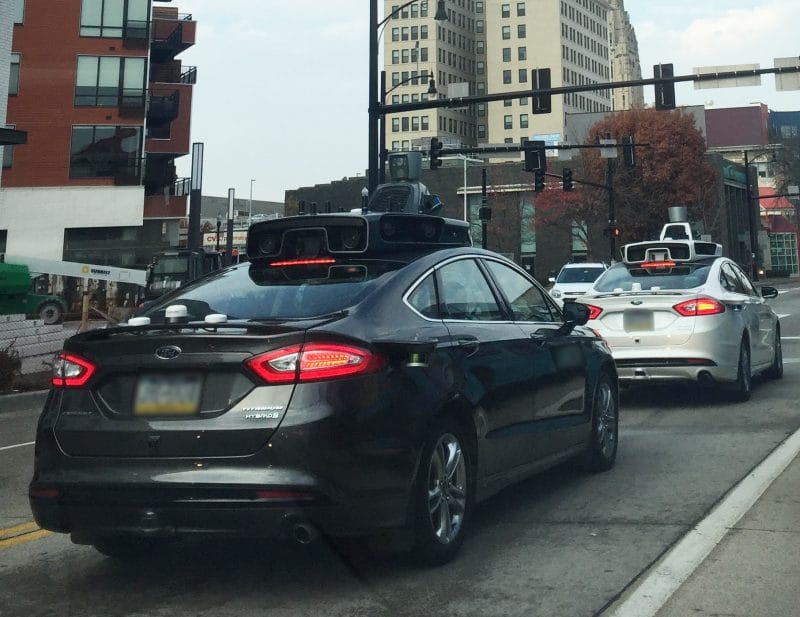AV Survey Results 2017
The Age of Autonomous Vehicles
Background
Autonomous Vehicle (AV) companies have been testing autonomous vehicles, and even picking up passengers, on Pittsburgh streets since September 2016 without any high profile incidents. For the most part, citizens and public officials have greeted them (and the AV industry in general) with open arms. Additionally, the Federal Government officially designated Pittsburgh as one of ten “proving grounds” for AVs, with PennDOT citing Pittsburgh’s streets, bridges, tunnels and cyclists in its pitch. Since then, there has been an enormous growth of AVs on Pittsburgh streets, many of which, like Penn Ave and Smallman St through the Strip District, are popular cycling routes.
In December 2016, Uber launched their autonomous vehicles (AVs) in San Francisco without seeking a permit, and immediately started a firestorm. On a drive with San Francisco Bicycle Coalition staff upon introducing AVs to the City, an Uber AV performed a dangerous maneuver and turned illegally across a bike lane. Then, a video surfaced of another Uber AV blowing through a red light. This eventually led to a fight with City and California state officials, and ultimately the company temporarily pulled the plug on their San Francisco AV experiment.
However, after a report from Ford about AV engineers falling asleep at the wheel, combined with a handful of complaints about AVs trickling into our inboxes at BikePGH, we felt that we needed to highlight and better understand this issue. Within these complaints some common themes emerged – people have no place to provide feedback on their interactions with AVs, nor with how they feel about being included in a potentially dangerous experiment.
While our staff’s personal experiences riding and walking alongside AVs have been mostly neutral or even positive, we believe that the introduction of these vehicles to our streets deserves a larger conversation. So, we set out to design a survey to see both how our donor-members, and Pittsburgh residents at large, feel about about sharing the road with AVs as a bicyclist and/or as a pedestrian. At the time, we were unaware of any public surveys about people’s feelings or understanding of this new technology.
Bikepgh Survey on Autonomous Vehicles – published March 2017
Last week, AAA released the results of a nationwide survey of about 1,000 participants. Not surprisingly, the AAA survey showed that the nation is not quite ready to accept robot cars. The survey also showed that the respondents believe that they are better drivers than robots. However, the AAA survey presupposes that people will be giving up their cars for AVs.
Our survey, on the other hand, asked participants how they feel about being a fellow road user with AVs, either walking or biking. We also wanted to collect stories about people’s experiences interacting with this nascent technology. The difference between our survey and the AAA survey tries to get to the heart of what an AV future will look like – will we maintain the car ownership model where everyone drives themselves to work in their own private vehicle, or will people ditch their cars for the “shared” model where you don’t have to worry about parking, maintenance, and insurance?
Coincidentally, a few days later, the study “Driverless Future: A Policy Roadmap for City Leaders” was released. The study articulated this very issue and recommends that city leaders not delay any longer and create policy around AVs so that we end up with the positive results of safety, less congestion, and a reduced need for parking. Left unchecked, the technology could “face major risks” and lead to more congestion, more pollution, and a diversion of funds from public transit, leaving stranded those who can’t afford a lift.
We conducted our survey in two parts. First, we launched the survey exclusively to donor-members, yielding 321 responses (out of 2,900) via email. Once we closed the survey, we launched it again, but allowed the general public to take it. Through promoting it on our website, social media channels, and a few news articles, we yielded 798 responses (mostly from people in the Pittsburgh region), for a combined total of 1,119 responses.
We hope that our results will help add to the body of data and help the public and politicians understand the complexity of possible futures that different economic models AV technology can bring to our cities and towncenters. Admittedly, the results of the survey were surprising, and will influence how BikePGH will approach our work as it relates to AVs and keeping bike riders and pedestrians safe.
Additionally, we feel that this data is valuable for the public good. We have released the raw data to the Western Pennsylvania Regional Data Center (WPRDC) so that others can explore, process, and conduct new and different analyses. AVs have the potential to dramatically shape our cities and public spaces. We’re at a crossroads, and the decisions that Pittsburgh leaders make will decide whether our cities conform to AVs or if we make AVs conform to the places in which we want to live.
Key Findings
There was an even split in those surveyed between those with on-the-street experience with AVs and those who had none.
One interesting finding was that our membership is slightly more supportive of AVs using Pittsburgh’s streets as a proving ground than the general Pittsburgh public. When broken down by experience level, the difference between members and the public is even greater.

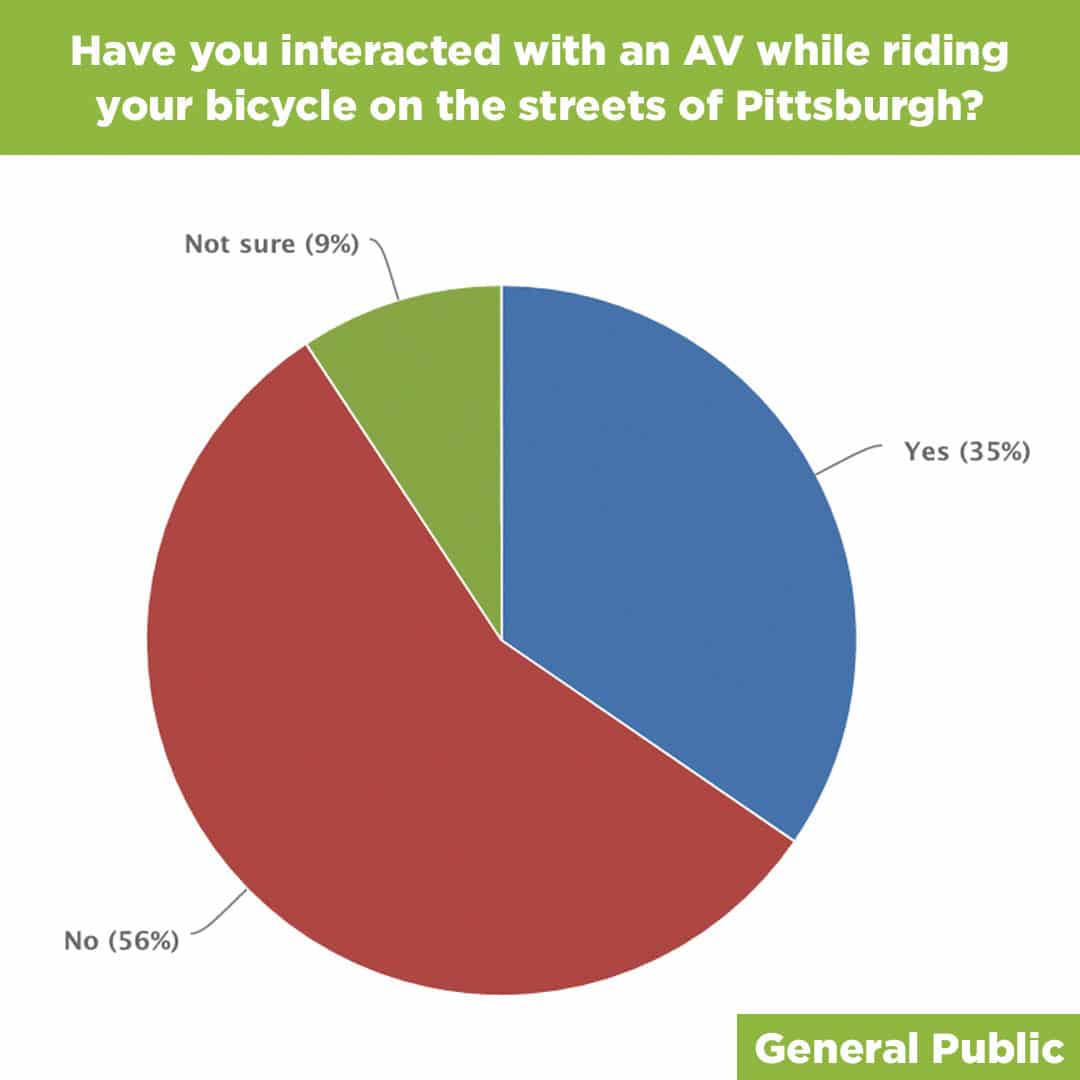
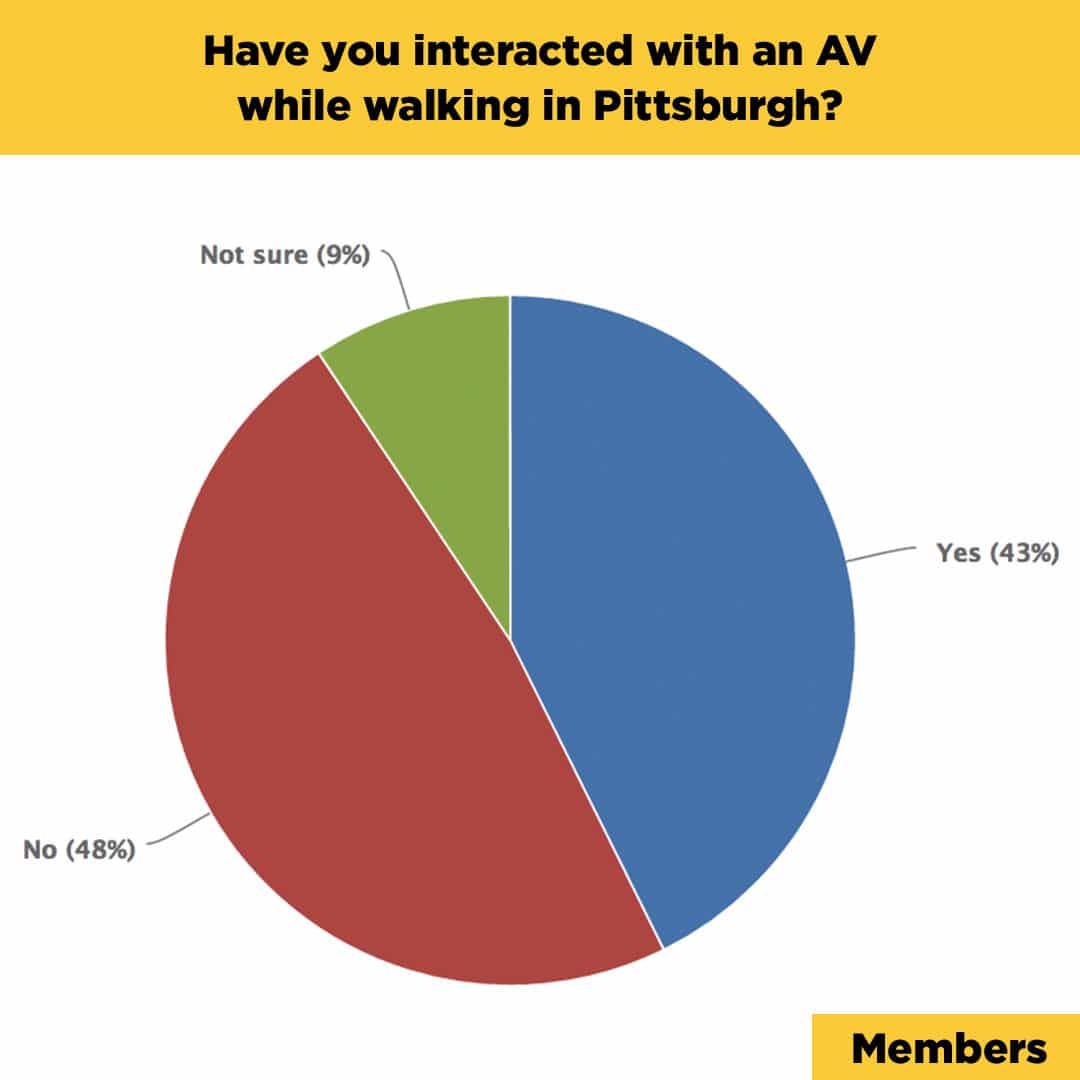

Pittsburgh PROVING GROUND
Among our membership, only about 10% of those with experience sharing the road and 10% of those without experience sharing the road with AVs while riding a bicycle, disapprove of Pittsburgh as an AV test bed. Of the public responses, about 20% of those who have no experience riding alongside AVs disapprove, while 16% of those who have interacted with AVs disapprove. These results illustrate that the more experience people have with AVs, the more they are likely to accept them.
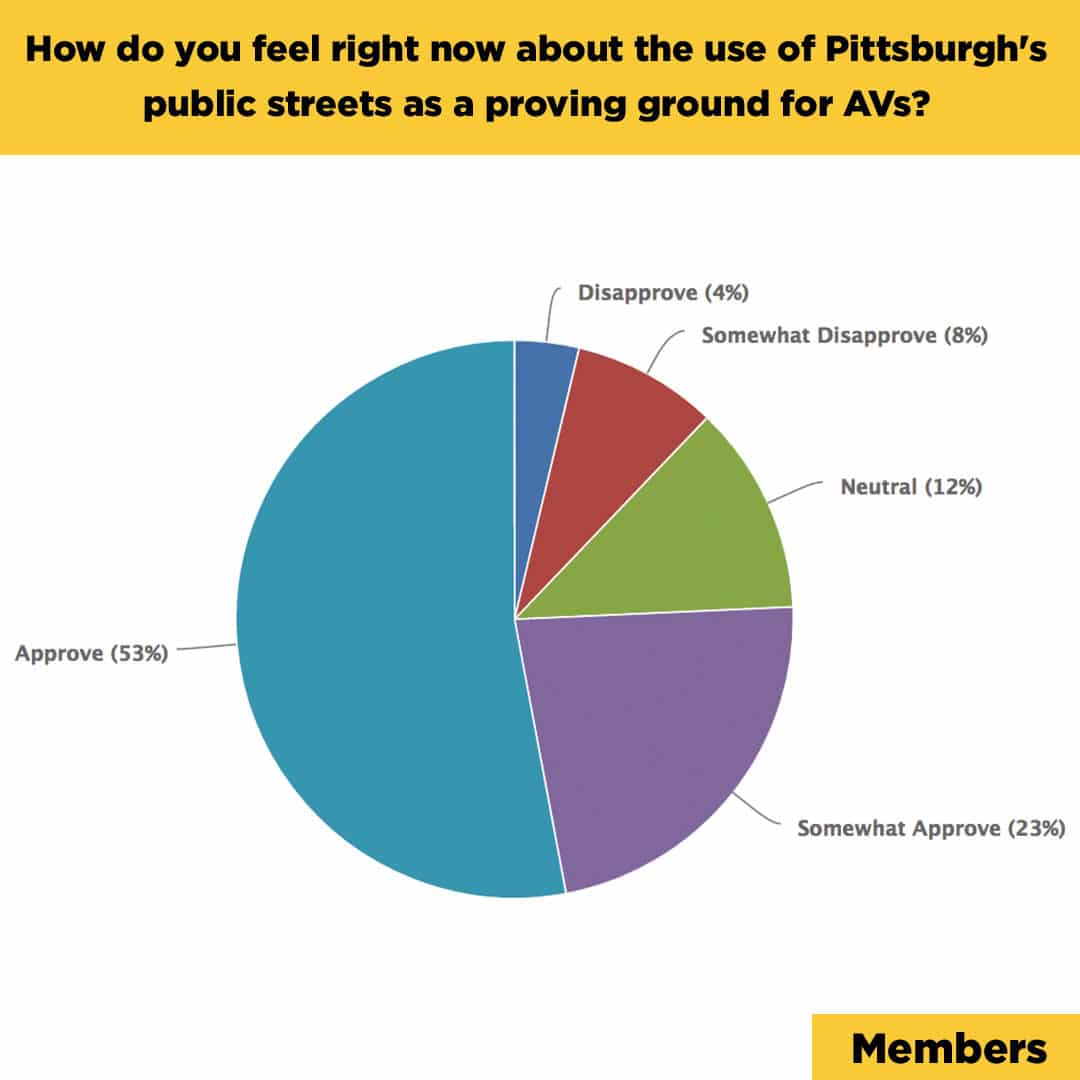

In general, people were very welcoming of the safety benefits of removing humans from the driver’s seat, and think AVs can’t come soon enough.
Humans vs Autonomous Vehicles
Most of the open-ended answers were overwhelmingly neutral to positive. For instance, numerous people noted how AVs traveled the speed limit, were cautious, were predictable, didn’t block the crosswalk at a red light, and used turn signals, “which automatically sets them apart,” according to one respondent. Many people felt that the AVs had an overall traffic calming effect, as it only takes one vehicle traveling the speed limit to act as a pace car for every other vehicle behind it.
While many people interact with AVs multiple times per day, most reports were generally uneventful or positive. Also, many people noticed that the AVs yielded to pedestrians in crosswalks, or passed them as they were bicycling with the legal 4 feet of space. Additionally, people noted the lack of road rage and aggression towards them as opposed to human drivers, however many were not comfortable with the dehumanization of the interaction even if it ended up being safe.
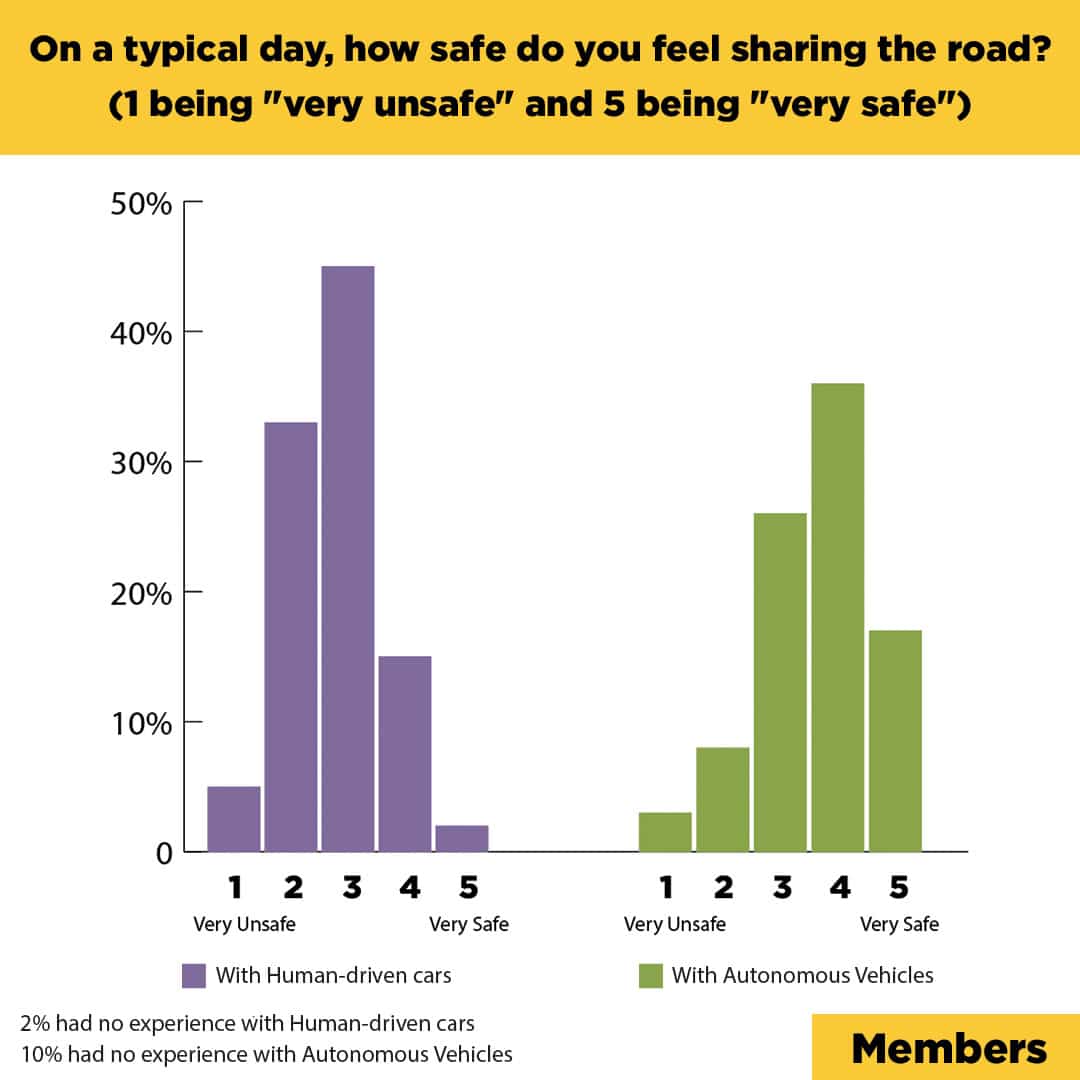
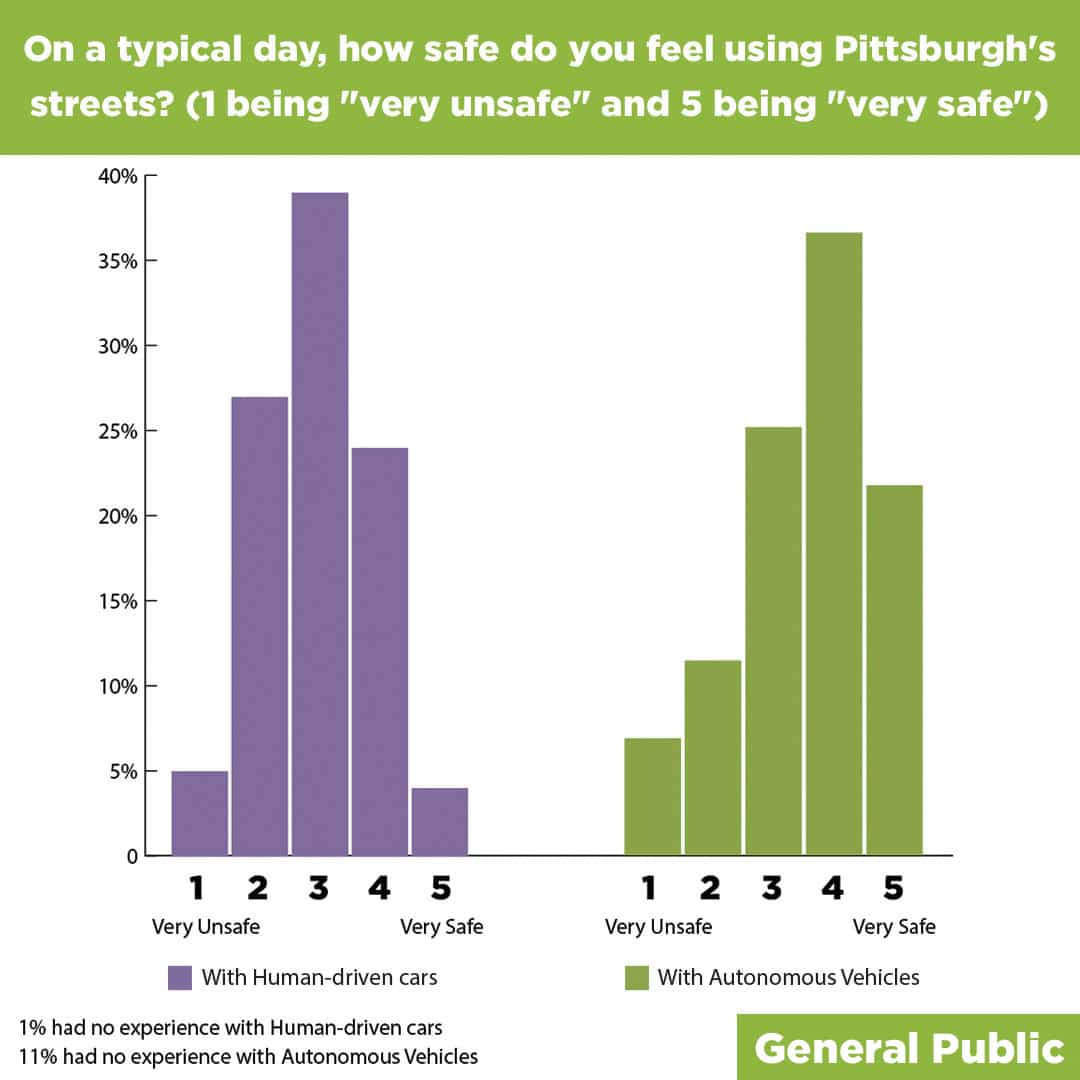
Observations & ExperIences
“Human drivers tend to show more signs of being nervous when passing, and the AV has actually been very controlled and predictable.”
“I got the feeling that the car was being more careful than most drivers would be.”
“Even an aggressive motorist recognizes that I am a road user and will often be able to read the situation…AVs drive by with the same level of concern as if I was an inanimate object.”
Potential to REDUCE INJURIES & FATALITIES
In general, people’s disdain for rude and aggressive human drivers overshadowed any negative perception, if not even welcomed autonomous vehicles. “Their novelty should not obscure the fact that they are neither distracted, intoxicated, nor aggressive, unlike the far more numerous human operators I encounter on the roads.” This commenter followed with “if [BikePGH] truly cares about cyclists’ safety, you would work to minimize the latter, rather than the former.”
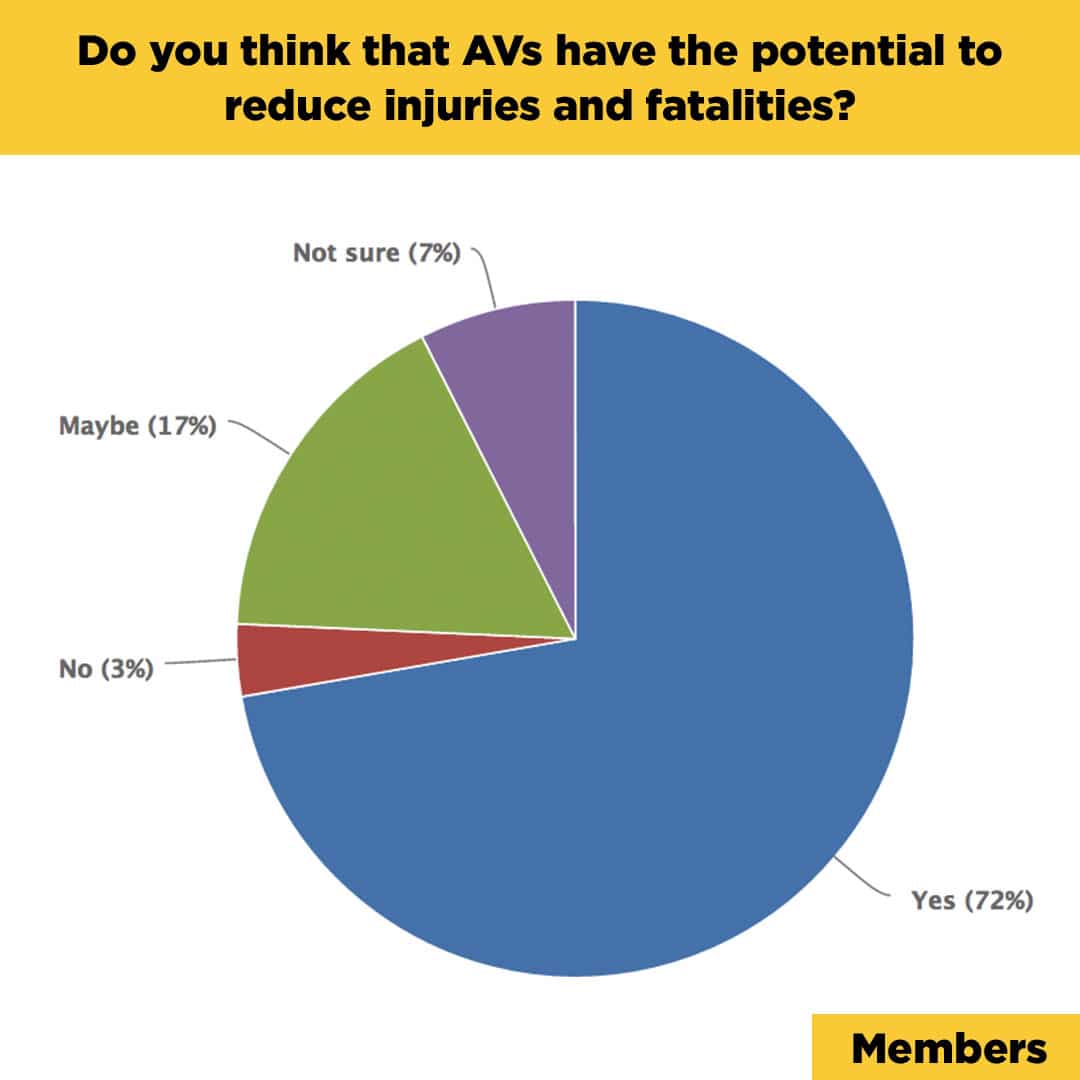

There were of course some negative comments towards AVs as well. Although these were clearly the exception, it speaks to how we simply don’t know what’s going on and are unsure if it’s a robot controlling the car or a human engineer. Many people noted how the AVs give them anxiety, or how it “freaks me out,” but still end up witnessing them do the right thing.
Several people noted how, as a pedestrian, the AV did not stop for them while they were waiting to cross in a crosswalk, a dynamic that seems especially problematic in crosswalks at unsignalized intersections. An observer even remarked how they seem to “ignore crosswalks.” This, combined with the inability to make eye contact with a driver, gave a general sense of unease and distrust towards them. There were many reports of the odd behavior that the AVs exhibited in response to the unpredictability of pedestrians.
Some noted how the AVs tended to hug the line next to a bike lane, while human drivers tended to drive closer to the centerline when driving next to a bike lane with a bicyclist present. Contrary to other observations, several people noted that, while bicycling, the AV did not give them the proper 4 feet of space during a pass, in accordance with Pennsylvania law.
Observations & Experiences
“I know how to tell if a human driver can see me, but how do i know if AI sees me?”
“I don’t feel that I am entitled as a rider to any special courtesies or privileges….but human communication and judgement in these and many other situations is reassuring.”
“They can’t do what human drivers do, which I get upset about the fact that I’m biking and pretend like they didn’t see me.”
“The car obeys a logic that is by definition not human and I do not know how to anticipate its behavior.”
One participant noted how an “AV cannot do illegal things because it is not programmed to do them – for example, when I rode in an AV, it could not make the ‘Pittsburgh Left,” and because it was holding the traffic pattern (the car on the other side of the light was waving us through and would not move until we did) the driver eventually took over to make the left.”
Someone else even noted that the AV was “super-cautious” making the interaction unpredictable, because the rider is “used to the usual aggressive drivers and can often judge what an aggressive driver is going to do.” If anything, the survey tells us how low the bar is for safe, considerate driving is in Pittsburgh and may serve more as an indictment of local drivers. With that said, there is still a high level of scrutiny on how AVs behave.
Another participant stated that, “the most danger I feel around self-driving cars is the way they make regular car drivers feel. I mostly see them frustrating and confusing other car drivers,” who “when mad…become very reckless and speed way up.”
One respondent frequently runs on the road, and notes that AVs “never move away from me like all the rest of the cars on the road. Several times the side mirrors have come within 6 inches of my shoulder.”
A bicyclist also experienced an AV pass him and his partner with only 6 inches to spare, and are “convinced that the AV never ‘saw’ us.”
Another witnessed an AV approach “a one way in the opposite direction…but the AV kept going the wrong way through the one way…and it looked like the driver overtook controls and backed the car out of the one way.” Yet another witnessed an AV running a red light.
The worst interaction, by far, was a bicyclist who reported that, on Penn Ave, the AV “went full speed past me in the same lane I was in” and the rider felt the “vehicle hit me with their side mirror.” To make matters worse, when confronted about the incident, the driver refused to roll down the window and did not acknowledge the interaction. The rider contacted Uber, who ultimately denied it.
Which leads to the biggest criticism, by far, is how the companies have responded to public inquiries or complaints. For instance, one person noted that while riding in an AV during stop-and-go traffic, “the car didn’t automatically stop and the person in the driver seat had to slam on the brakes to avoid hitting a pedestrian. He then lied and said he didn’t intervene, when I could clearly see on the computer screen that it asked what the reason for intervention was.”
Regulation
For the most part, people were in support of limited government regulation of the testing of AVs.
When it came to details, people were mixed on whether to cap the maximum speed in which cars can operate autonomously, as well as mixed on preventing AVs from operating in an active school zone. People overwhelming think that the AV companies should share data with the proper authorities. There were, however, several open ended responses where people believe that AV companies should be required to report any crash, even if a police report isn’t required by law.

Respondents predictably think that it’s a good thing that BikePGH is raising this issue to ensure that AVs are responsive to the unique characteristics of bicyclists and pedestrians. Bikes and peds are clearly a challenge for AV developers, so it’s important to people that they are designed with all potential scenarios in mind. Many of our members strongly encourage us to partner and work with the AV companies on these issues.
A large number of respondents were excited that Pittsburgh is “ground zero” for autonomous vehicle technology, and suggest that how we develop legislation, policy, and safety features will likely influence how the nation responds. Many welcomed the economic potential of a new industry and the jobs that may follow.
Other common responses revolved around the labor issues and potential loss of jobs the technology will surely bring, and feel that we need to have “a conversation about how to support the current drivers’ transition to other employment.”
BIKEPGH POSITION
While it’s impossible to know when an AV is in self-driving mode or is human operated, people clearly want transparency and accountability, and as long as it’s left to nonprofits to collect anecdotes, people will be slow to trust the AV companies, especially if they deny problems with the technology or blame their drivers whenever something goes wrong. When a negative interaction occurs, most people will assume that it’s the fault of the robot, so it’s up to AV companies to take responsibility and create a clear course for improvement.

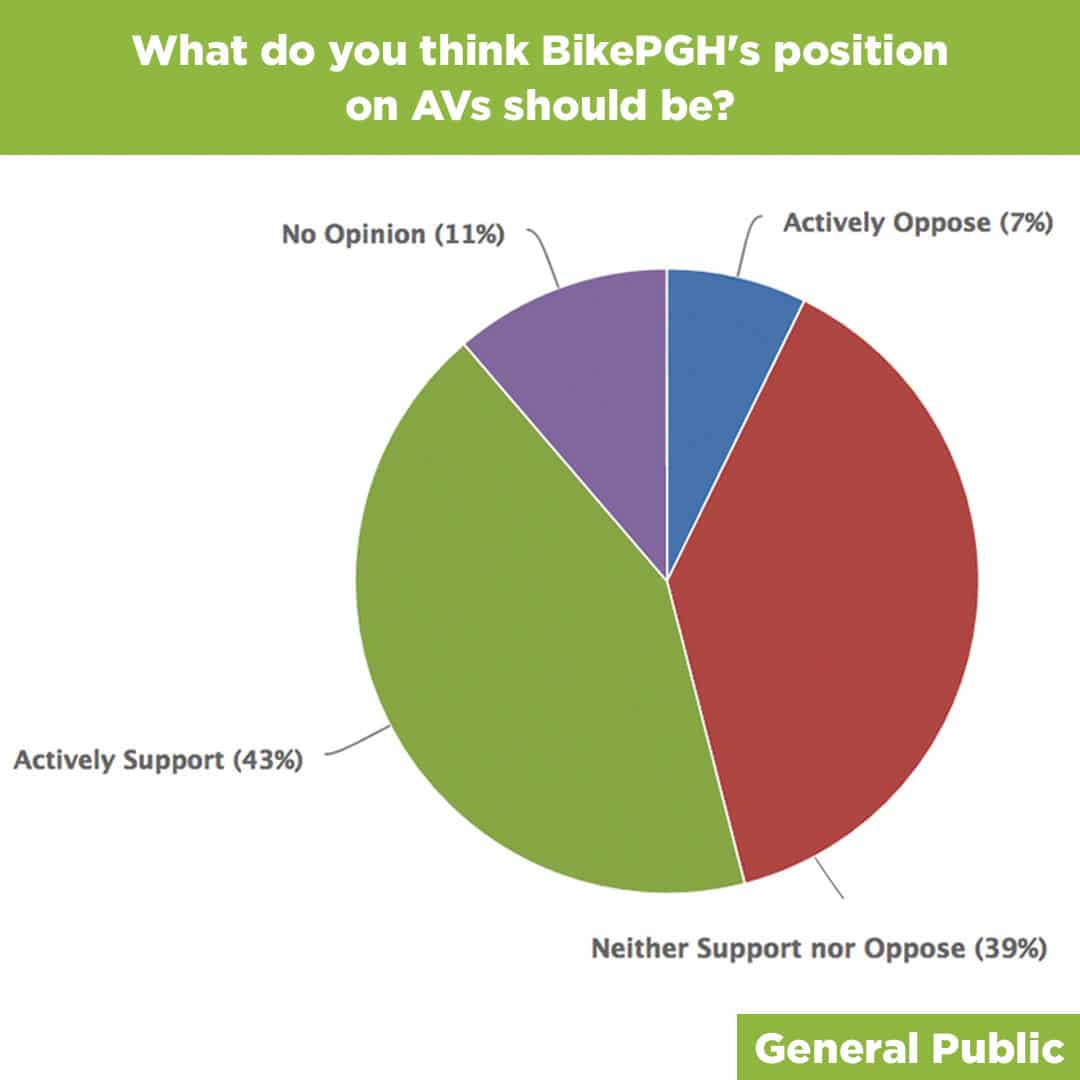
This can be summed up with a quote from participant who said:
“I was going to call Uber and complain, but I realized that they don’t even have phone numbers for their drivers to call with issues, so they probably don’t for people who almost got hit by their cars.”
Which brings us to what why we created the SAVE form.
Submit Autonomous Vehicle Experience (SAVE)
The survey supported our hunch that there was demand for a place for people to submit their personal experiences with AVs. To address this, we have created the Submit Autonomous Vehicle Experience (SAVE) form. The data collected will provide valuable information to everyone from policy makers to AV developers to help keep us all safe.
The form will allow users of our streets to submit their interactions with Autonomous Vehicles and will be helpful in determining how BikePGH approaches its advocacy and education regarding AVs.
Click here to share your experience
More Survey Results
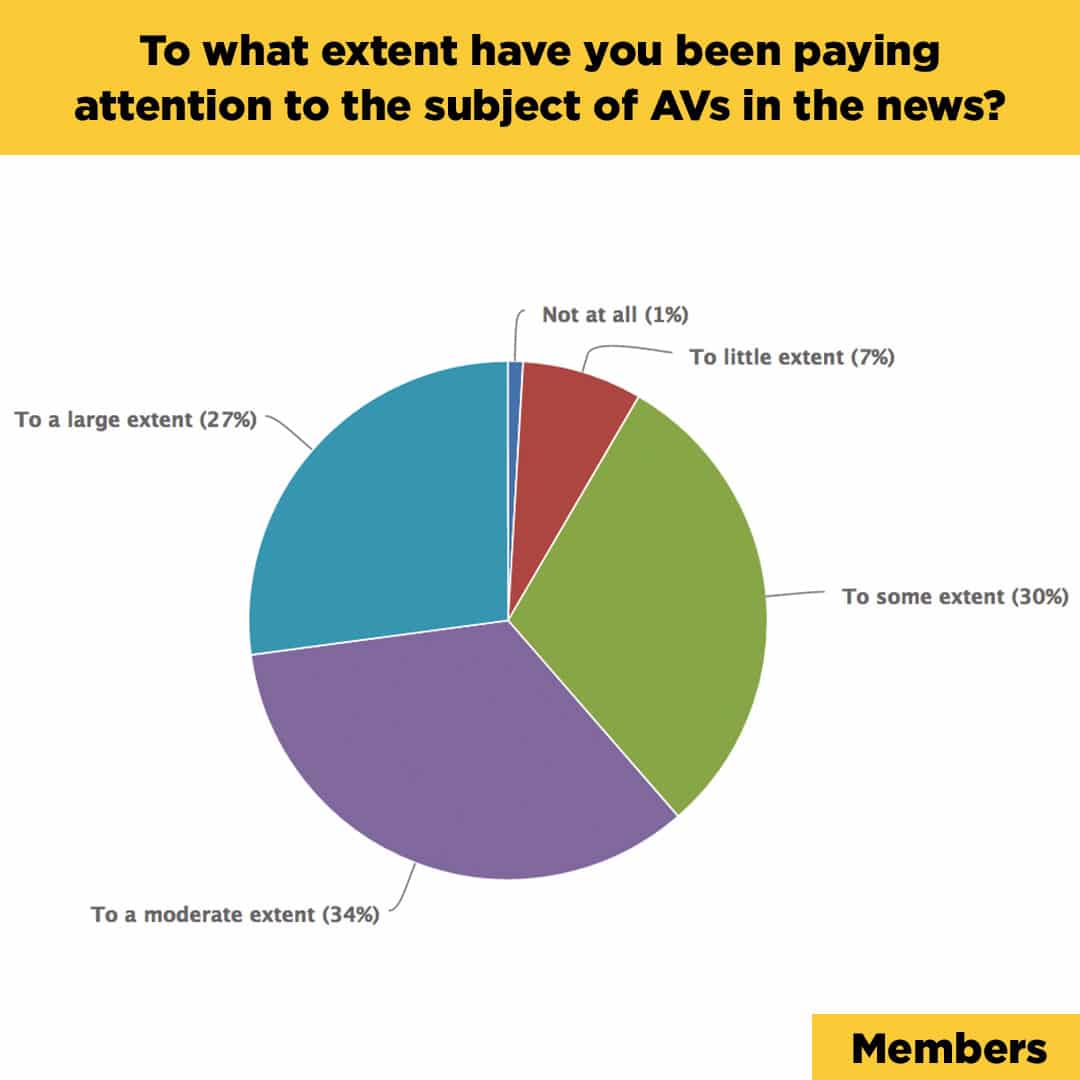
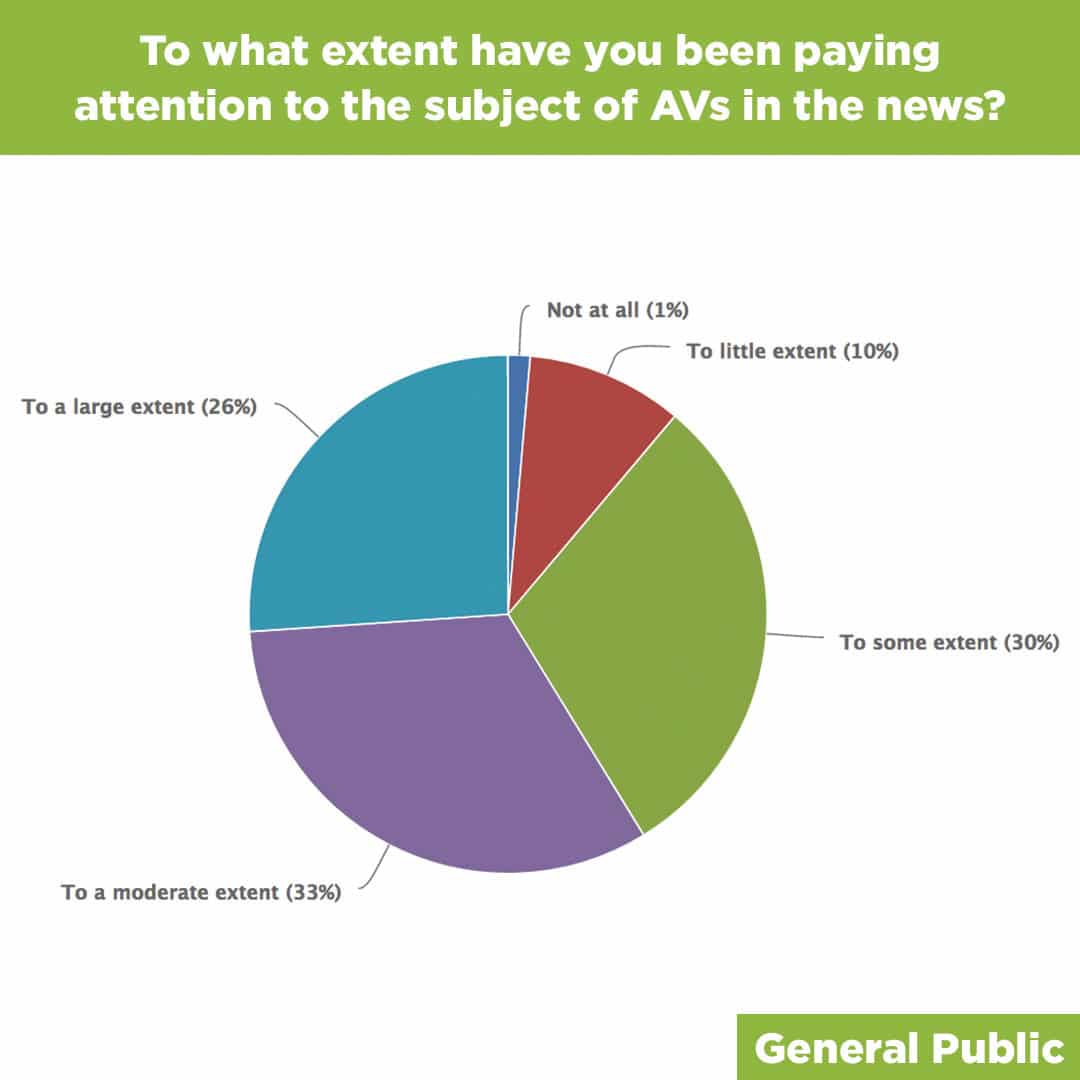

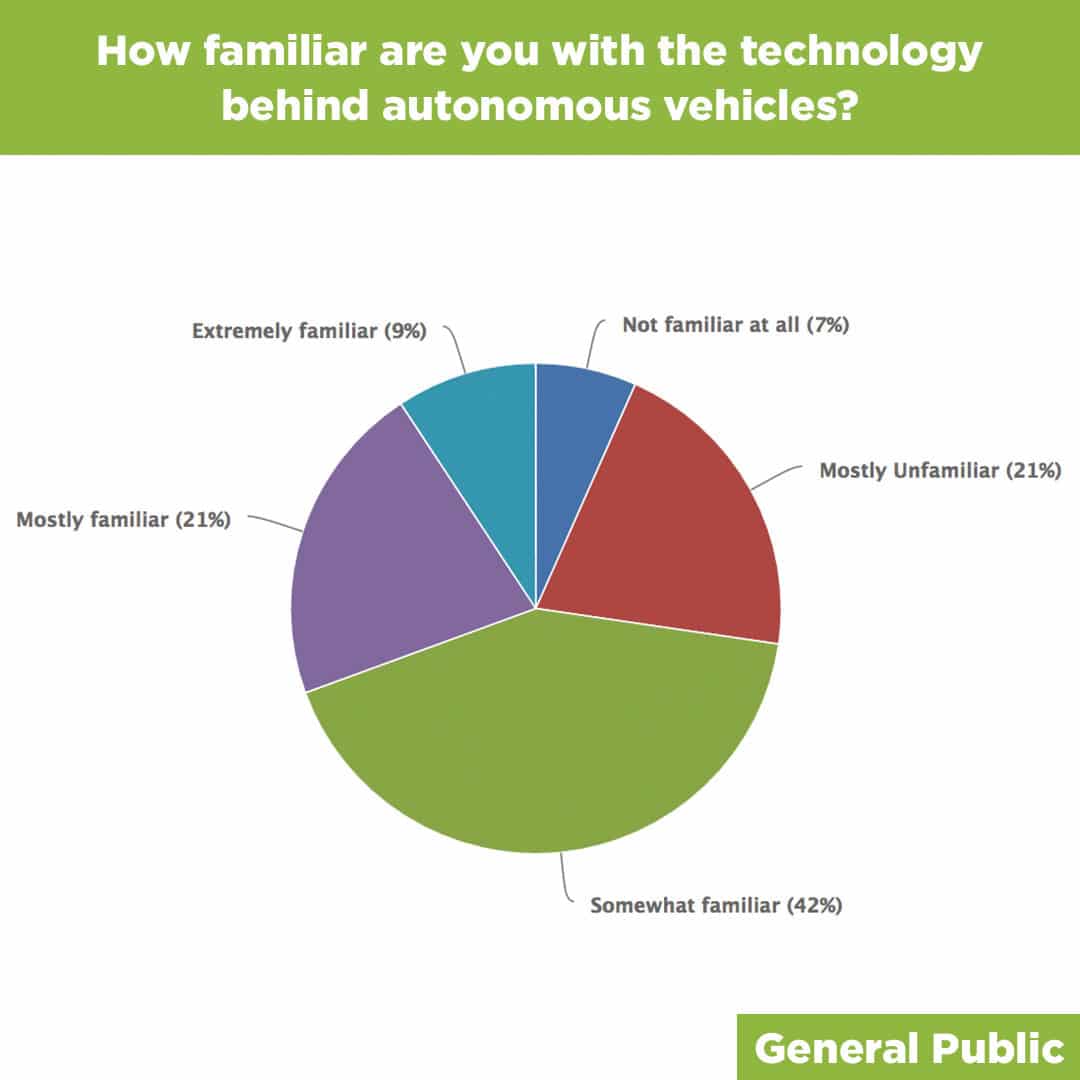
Report compiled by BikePGH staff Eric Boerer, with special thanks to the Western Pennsylvania Regional Data Center.
Sign up for Bike Pittsburgh’s newsletter, The Messenger, to get the latest news on events, bike and pedestrian infrastructure, and fun, delivered straight to your inbox. Twice monthly emails, no spam.
Sign Up!